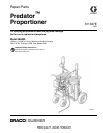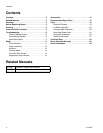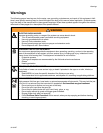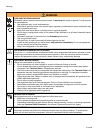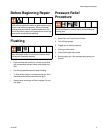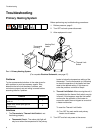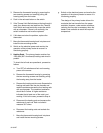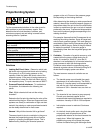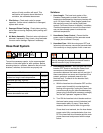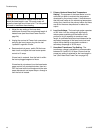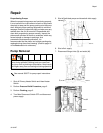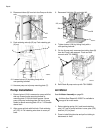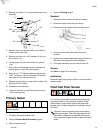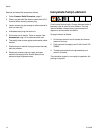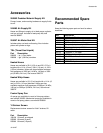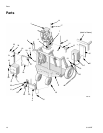
Troubleshooting
8 311327E
Proportionting System
Problems
Try the recommended solutions in the order given for
each problem to avoid unnecessary repairs. Also,
determine that all circuit breakers, switches, and
controls are properly set and wiring is correct before
assuming there is a problem.
Solutions
1. Leaking Ball Check Valve - Determine which inlet
ball check valve or piston ball check valve is leaking.
If the pump (A or R) is losing pressure on the
upstroke, check the piston ball check valve of the
respective pump. If the pump is losing pressure on
the downstroke, check the inlet ball check valve of
the respective pump. To repair, see manual 309577.
2. Pressure/Chemical Imbalance - To troubleshoot
this problem, first determine the following two
points:
First - Which chemical did not exit the mixing
chamber?
Determine the first point by checking the color of the
material exiting the gun. Since two-component foam
systems are usually a combination of light and dark
material, the missing or under-proportioned material
can be readily determined in most cases.
Second - Why did the chemical fail to get there?
The second point is due to a restriction in the gun or
because the proportioning pump did not function
properly in pumping its designed volume. This is
determined by checking the chemical pressure
gauges on the unit. Focus on the pressure gauge
corresponding to the missing chemical.
After determining the missing or under-proportioned
material, observe the chemical pressure gauges on
the problem side of the unit to see if the malfunction
is due to a restriction at the gun or a lack of material
produced by thepump. To prevent misinterpretation,
focus on the pressure gauge corresponding to the
missing chemical.
For example: Assume that the R-component is not
reaching the mixing chamber. Spray off target and
note the resin pressure gauge; if the resin gauge is
considerably higher than the isocyanate gauge, the
problem is within the gun. Refer to the gun manual
to resolve the problem. If the resin gauge is
considerably lower than the isocyanate gauge, see
Solution 3.
3. Cavitation - Formation of a partial vacuum or void
created within the pump cylinder during the fill
stroke. It is actually a “short fill”, since the fill
chamber is not completely full of chemical when the
pump reverses to start the discharge stroke.
Cavitation occurs when the proportioning pump
demands a greater volume of material during its fill
stroke than the supply system can deliver.
The most common causes of cavitation are as
follows:
a. The transfer pump cannot handle the supply
requirement or is malfunctioning. The Graco-
Gusmer 2:1 transfer pump is recommended for
use with the unit. Also recommended is a
minimum of 3/4 in. diameter hose, as short as
possible.
b. The chemical is too viscous to pump properly.
Consult your chemical supplier for the
recommended material temperature required to
maintain a viscosity of 250 to 1500 centipose.
c. Inlet strainer screen is restricted. Service as
required.
d. An inlet ball check and/or seat o-ring that does
not properly seal will permit some of the
proportioned material to flow back towards the
supply drum. When this happens, the
proportioning pump will not pump the proper
volume of material during the discharge stroke
Problem Solution
Proportioning pump does not hold pressure
when installed.
1
Proportioning pump does not build pressure
on the upstroke.
1,6
Pressure imbalance between pumps. 2,3,1
Cavitation in the proportioning pump. 2,3,1
Pump movement is erratic. 5,6
Failure of pump to reverse. 4,5,6



